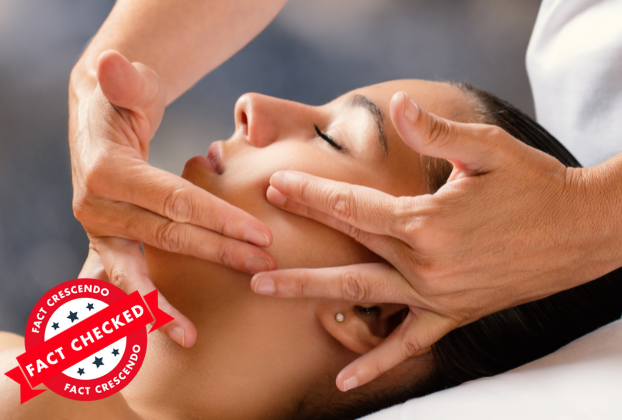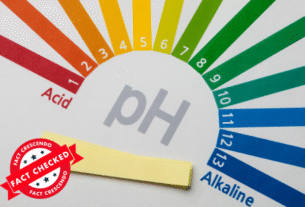A recent social media video has been circulating that demonstrates facial self-massage techniques, such as upward forehead movements and circular cheek motions, which are claimed to reduce wrinkles and provide anti-aging benefits. While scientific studies do show some real benefits, the evidence is not as dramatic as social media makes it sound.
Social Media Post
A viral social media video demonstrates facial self-massage techniques with the caption “Facial Massage to Eliminate Wrinkles Now” has recently gained attention and been shared widely on Facebook.
Fact Check
Measurable Structural Changes
Some studies suggest that facial massage does more than just feel relaxing, it can create small but measurable changes in the face. A 2022 study published in Skin Research and Technology used CT scans to track what happens when people massage their own faces twice a day for two weeks.
The results were striking: participants showed a slight thinning of cheek fat, a small upward shift of tissue, and an increase in the height of the connective layer that helps keep skin firm. The researchers concluded that massage produced a genuine “lifting and tightening effect.”
It’s important to note that the study’s sample size was limited and only examined effects over a two-week period, making it difficult to determine if these changes persist over longer timeframes. The research does, however, provide preliminary evidence that facial massage can create physical changes in facial tissues beyond temporary improvements in appearance.
Protein Expression and Collagen Support
The promise of facial massage also comes from laboratory research looking at the skin on a cellular level. A 2017 study funded by L’Oréal and published in PLoS One found that when massage was combined with skincare products, the skin produced more of the proteins needed for elasticity and firmness. Specifically, the study reported increases in tropoelastin (an elastin precursor) and procollagen-1 (a collagen precursor).
Participants in the trial also showed visible improvements in wrinkles on their foreheads and cheeks over eight weeks. This suggests massage may help the skin respond better to products and stimulate the building blocks of firmness.
Also, it is worth noting that this study was sponsored by the beauty industry, and few independent researchers have verified these results.
Circulation and Blood Flow Benefits
One of the most consistent findings about facial massage is its effect on circulation. When you rub or roll the skin, blood vessels open up, which increases blood flow to the area. A 2018 study found that using a massage roller not only boosted circulation immediately but also improved the skin’s response to heat over several weeks.
The improved circulation delivers oxygen and nutrients to skin cells, resulting in a healthier appearance and potentially enhanced repair processes. However, these benefits remain temporary, typically lasting only for a short period after treatment. This transient effect should not be mistaken for a permanent solution to wrinkles or aging concerns. (Sources: Healthline; Kaizen Health Group)
Professional and Mechanistic Support
Beyond circulation, experts point to two other ways massage may help. First, it supports the lymphatic system, which moves fluid through the body. Gentle massage can reduce puffiness, help drain excess fluid, and even sharpen facial contours when done consistently.
Second, scientists have proposed something called mechanotransduction, basically, when you press or stretch skin cells, they respond by activating fibroblasts, the cells that produce collagen. In theory, this could explain why massage may encourage firmer, healthier-looking skin. (Source)
A 2025 report in Dermatology Times even concluded that gua sha tools and rollers improved skin elasticity and tone in a measurable way, with the added advantage of being safe and having no downtime compared to some energy-based cosmetic procedures.
Arguments Against the Claims
While the evidence above sounds promising, medical authorities urge caution. Medical News Today points out that there is “no conclusive scientific proof” that facial massage significantly changes visible signs of aging. They emphasize that most studies are small, short, and often industry-funded.
Some fascia specialists present a different perspective. In an article in The Conversation, a specialist suggests that massage might potentially affect collagen fibers in ways that could impact skin elasticity over time. They also point out that fibroblasts naturally produce less collagen as we age, a process that may not be significantly altered through massage techniques alone.
The Cleveland Clinic agrees that more research is needed, stressing that dermatologists cannot yet recommend massage as a proven anti-aging treatment. Experts also note contradictions: massage videos often promise a leaner face by draining fluid, but many anti-aging products focus on adding volume back to make the skin look youthful.
Expert Perspectives
Expert opinions vary on the effectiveness of facial massage. Some health professionals and dermatologists acknowledge that massage can improve circulation, help relieve facial tension, and potentially enhance product absorption. These effects may make it a beneficial addition to skincare routines, though more research is needed to confirm long-term benefits.
On the skeptical side, medical publications emphasize the lack of large, high-quality studies. Without stronger evidence, they argue, massage should be seen as a complementary wellness practice, not a miracle cure for aging. (Source)
Furthermore, Fact Crescendo has reached out to an expert, Dr. Chakrit Pimsorm, Anesthesiologist and Aesthetic Medicine Practitioner in Khon Kaen, Thailand. Dr. Pimsorm explained to Fact Crescendo Team that when it comes to forehead wrinkles, massage alone is unlikely to provide lasting improvement. “There may be a temporary tightening effect right after massage, the skin can feel firmer for a few minutes, but this is short-lived and quickly returns to normal,” he said. He compared the effect to facial devices that create a momentary sensation of firmness without producing long-term structural change.
Dr. Pimsorm also cautioned that in the viral video, the demonstrator’s technique appeared too forceful: “The harder you press, the more you risk creating folds in the skin. This can make some areas look tight while others crease, which is the opposite of the intended anti-aging result.”
Conclusion
Based on the evidence, facial massage offers real but modest benefits. It can improve circulation, support lymphatic drainage, and create some measurable structural changes in facial tissues. However, claims about dramatic anti-aging effects are not supported by robust scientific evidence. Those interested in facial massage should maintain realistic expectations, viewing it as a complementary practice that may enhance skincare routines rather than as a transformative anti-aging solution.

Title:Can Facial Massages Really Eliminate Wrinkles?
Fact Check By: Cielito WangResult:Missing Context






